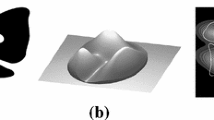Abstract
In the paper, a novel approach using affine transfer and scene constraint for estimation of 2D displacement field was developed. In this approach, we derived a system of 5 linear equations for computing corresponding point of any image point via the utilisation of affine invariant. Subsequently, the characteristics of such a linear system was thoroughly studied, and the way to obtain a reliable solution of the system via robust least squares (RLS) approach, in conjunction with total least squares technique, was proposed. In addition, through the interpretation of the approach from both geometric point of view and numerical point of view, we gave the limitation of the algorithm. The limitation was then relaxed to a certain extent by using full fundamental matrix. These findings were further verified through the experimental results.
Similar content being viewed by others
References
Anandan, P. 1989. A computational framework and an algorithm for the measurement of visual motion. International Journal of Computer Vision, 2:282–310.
Barron, J.L., Fleet, D.J., and Beauchemin, S.S. 1994. Systems and experiment performance of optical flow techniques. IJCV, 12(1): 43–77.
Bergen, J.R., Burt, P.J., Hingorani, R., and Peleg, S. 1992. A three-Frame algorithm for estimating two-component image motion. IEEE PAMI, 14(9).
Boyd, S. and Vandenberghe, L. 1997. Introduction to convex optimisation with engineering applications. Course Notes. http://www.stanford.edu/class/ee364.
Burt, P.J. and Adelson, E.H. 1983. The Laplacian pyramid as a compact image code. IEEE Transactions on Communication, 31:532–540.
Chin, T.M., William, C.K., and Alan, S.W. 1994. Probabilistic and sequential computation of optical flow using temporal coherence. IEEE Transaction on Image Processing, 3(6):773–788.
Deriche, R., Zhang, Z., Luong, Q.T., and Faugeras, O. 1994. Robust recovery of the epipolar geometry for an uncalibrated stereo rig. ECCV'94, pp. 567–576.
Faugeras, O.D. 1995. Stratification of three-dimensional vision: projective, affine and metric representation. Journal of the Optical Society of American, 12(3):465–484.
Fuh, C.S. and Maragos, P. 1991. Motion displacement estimation using an affine model for image matching. Optical Engineer, 30(7):88–94.
Ghaout, L.E. and Lebret, H. 1997. Robust solutions to least-squares problem with uncertain data. SIAM J. Matrix Anay. Appl., 18(4): 1035–1064.
Hildreth, E.C. 1984. The Measurement of Visual Motion. MIT Press: Cambridge, MA.
Horn, B.K.P. and Schunck, B.G. 1981. Determining optical flow. Artificial Intelligence, 17:185–203.
Lucas, B.D. and Kanade, T. 1981. An iterative image registration technique with an application to stereo vision. in Proc. 7th International Conference on Artificial Intelligence.
Luong, Q.-T. and Faugeras, O.D. 1994. A stability analysis of the fundamental matrix. ECCV'94, pp. 577–588.
Mundy, J.L. and Zisserman, A.P. 1992. Geometric Invariance in Computer Vision. MIT Press: Cambridge, MA.
Nagel, H.H. and Enkelmann, W. 1986. An investigation of smoothness constraints for the estimation of displacements vector fields from image sequence. IEEE Trans. PAMI, 8:565–593.
Nesterov, Y. and Nemirovsky, A. 1994. Interior-point polynomial methods in convex programming. Studies in Applied Mathematics, vol. 13. SIAM: Philadelphia, PA.
Nobel, A.J. 1988. Finding corners. Image and Vision Computing, 6(2):121–128.
Reid, I.D. and Murray, D.W. 1996. Active tracking of foveated feature clusters using affine structure. IJCV, 18:41–60.
Rousseeuw, P.J. and Leroy, A.M. 1987. Robust Regression and outlier Detection. John Wiley & Sons: New York.
Shapiro, L.S., Zisserman, A., and Brady, M. 1994. Motion from point matches using affine epipolar geometry. ECCV'94, pp. 73–84.
Singh, A. 1991. Optical Flow Computation: A Unified Perspective. IEEE Computer Society Press, Los Alamitos, CA.
Tomasi, C. and Kanade, T. 1991a. Shape and motion from Image streams: A factorization method-2. Point features in 3D motion. Technical Report CMU-CS-91-105, CMU, Pittsburgh, PA.
Tomasi, C. and Kanade, T. 1991b. Shape and motion from Image streams: A factorization method. Technical Report.CMU-CS-91-172, CMU, Pittsburgh, PA.
Torr, P.H.S. and Murray, D.W. 1997. The development and comparison of robust methods for estimating the fundamental matrix. International Journal of Computer Vision, 24(3):271–300.
Tsui, H.T., Zhang, Z.Y., and Kong, S.H. 1997. Feature tracking from an image sequence using geometric invariants. in Proceedings of CVPR'97, pp. 244–249.
Xu. G. and Zhang, Z. 1996. Epipolar Geometry in Stereo, Motion and Object Recognition: A Unified Approach. Kluwer Academic Publishers, Norwell, MA.
Zhang, Z. 1998. Determining the epipolar geometry and its uncertainty: A review. International Journal of Computer Vision, 27(2):161–195.
Author information
Authors and Affiliations
Rights and permissions
About this article
Cite this article
Yao, J. Estimation of 2D Displacement Field Based on Affine Geometric Invariance and Scene Constraints. International Journal of Computer Vision 46, 25–50 (2002). https://doi.org/10.1023/A:1013296015138
Issue Date:
DOI: https://doi.org/10.1023/A:1013296015138




